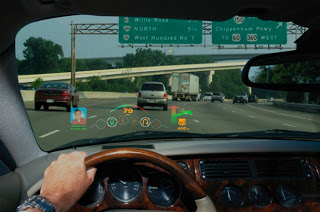Technology Review – Head-up displays, which project visual data onto the windshield and the driver’s view of the road, are debuting in a growing number of car models. But more vibrant, compact, and efficient displays being developed by Microvision, a company based in Redmond, Washington, could help the technology become much more common.
Japan’s Pioneer Corporation plans to release its first head-up display product based on Microvision’s novel display technology this year. Major carmakers in Detroit are also planning to integrate the technology into their vehicles by 2016, says Lance Evans, a director of business development at the company. Microvision’s image projector relies on semiconductor lasers and a microscopic mirror.
The company’s head-up display is already in some concept cars but has so far been too costly for commercial models, says Evans. Now, falling prices of green lasers—a significant cost component of the display—should make the technology competitive with conventional displays, he says.
On the road: A mock-up shows a driver’s view of Microvision’s heads-up display. Microvision
IPM is a miniature laser projection engine that provides automotive display manufacturers the power to create displays that boast exceptional image contrast, intense brightness, high-resolution and excellent dynamic color range.
Microvision’s system uses a set of three lasers—red, green and blue—and a single, millimeter-wide silicon mirror that tilts on two axes. The lasers put out light at different intensities, and the three colors are mixed to produce the final pixel color. As the lasers shine light on the mirror, it rapidly scans horizontally and vertically, painting the image onto the windshield one pixel at a time. This happens so fast that the image looks static. Evans says that the lasers’ pure, saturated colors result in more vivid images with a higher contrast ratio, so they are visible in daylight. Illuminating one pixel at a time also saves energy. And the use of a single mirror rather than an array makes the device smaller, simpler, and cheaper.
The final cost of Microvision’s product will hinge on the price tag of advanced green lasers. Materials for true green lasers have traditionally been difficult to engineer, so most green lasers contain semiconductors that emit infrared light, which is converted to green using complicated optics. In the past few years, though, half a dozen key players, such as Nichia,Osram Opto Semiconductors, and Soraa, have developed cheaper pure-green lasers. They’re slowly scaling up production, which should lower costs. Evans expects that costs should fall to a tenth of current levels by the end of this year.
“Green lasers alone are $200 each now,” he says. “Car companies are looking at the whole display to be that much.” Microvision’s laser-scanning display technology beats its competitors in terms of image quality, says Krishna Jayaraman, an analyst at Frost and Sullivan.
If you liked this article, please give it a quick review on ycombinator or StumbleUpon. Thanks

Brian Wang is a Futurist Thought Leader and a popular Science blogger with 1 million readers per month. His blog Nextbigfuture.com is ranked #1 Science News Blog. It covers many disruptive technology and trends including Space, Robotics, Artificial Intelligence, Medicine, Anti-aging Biotechnology, and Nanotechnology.
Known for identifying cutting edge technologies, he is currently a Co-Founder of a startup and fundraiser for high potential early-stage companies. He is the Head of Research for Allocations for deep technology investments and an Angel Investor at Space Angels.
A frequent speaker at corporations, he has been a TEDx speaker, a Singularity University speaker and guest at numerous interviews for radio and podcasts. He is open to public speaking and advising engagements.




